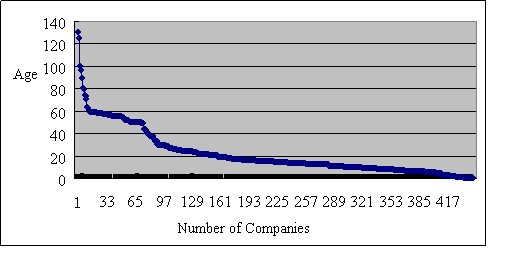IX. Other Features of Top 500 Companies of China in 2010
1. Focus on core businesses is prominent.
According to the data submitted by 471 companies, 43 of the Top 500 Companies of China in 2010 totally relied on their core businesses; there are 232 companies whose revenue from their core business accounted for 80~100 percent of the total revenue; 130 earning 50~80 percent from core business; and only 66 with a core business revenue proportion of less than 50 percent.
2. International business need be strengthened.
Generally, a company is labeled as "international" if its overseas revenue exceeds 30 percent of its total revenue. According to the data submitted by 248 companies, only 26 of the Top 500 Companies of China in 2010 had overseas revenue of more than 30 percent. Most of these companies largely focused on trade or intermediate products, except a minority of consumer goods companies including Youngor Group Co. Ltd and ZTE Corporation. This indicates that China’s big companies need further improve their international competitiveness.
Compared with the previous year, overseas revenue dropped significantly in 2010. According to the data submitted by 242 companies, only 2 had 1,000 percent growth in overseas revenue compared to 4 companies in the previous year. Moreover, 59.7 percent of the Top 500 Companies of China saw negative overseas revenue growth compared to 31.4 percent in 2009. For more details, please refer to Table 1-21.
Table 1-21. Overseas revenue growth of the Top 500 Companies of China in 2010
|
Growth Rate |
> 1,000 percent |
100-1,000 percent |
0-100 percent |
< 0 percent |
Total |
|
Number of Companies |
2 |
18 |
76 |
145 |
248 |
|
Proportion (percent) |
0.8 |
7.4 |
32.1 |
59.7 |
—— |
3. Mergers and reorganization were more active.
Among the Top 500 Companies of China in 2010, 155 went through the merger and reorganization process, involving 924 companies in total. As for the Top 500 in 2009, 146 went through reorganization, involving 644 companies. The number of companies reorganized has grown significantly, which shows that these companies have become more suitable for mergers.
4. Capital intensity increased.
The capital-labor ratio of a company measures its capital intensity as well as the efficiency of using capital goods. Statistics indicated that the capital intensity of the Top 500 Companies of China in 2010 has further increased. Per capita assets hit 3,360,700 yuan, up 18 percent from the previous year (2,840,000 yuan).
5. Age analysis of the Top 500 Companies of China in 2010
According to the data submitted by 445 companies, only 3 of the Top 500 Companies of China in 2010 are more than 100 years old, i.e., Kailuan (Group) Co. Ltd (130 years), Yunnan Tin Group (Holding) Co. Ltd (126 years) and the Bank of Communications (BOCOM) (101 years). 80 percent of the Top 500 are less than 30 years old. 28.3 percent are less than 10 years old while only 2.7 percent are more than 60 years old. For more details, please refer to Table 1-22.
Table 1-22. Age of the Top 500 Companies of China in 2010
|
Age |
> 100 years |
61~100 years |
31~60 years |
11~30 years |
< 10 years |
Total |
|
Number of Companies |
3 |
10 |
77 |
229 |
126 |
445 |
|
Proportion (percent) |
0.67 |
2.25 |
17.3 |
51.46 |
28.31 |
—— |

Figure 1-1. Age of the Top 500 Companies of China in 2010
According to the graph above, among the Top 500 Companies of China in 2010, 97.18 percent were established after the founding of the PRC in 1949 and 80 percent were after China's reform and opening up in 1978. For the past ten years, China's companies have been provided more development opportunities, due to economic globalization and further promotion of China's reform and opening up. 28.3 percent of the Top 500 Companies of China in 2010 were established during this period, which also witnessed the largest number of new companies. In a word, most of the Top 500 Companies of China in 2010 are less than 20 years old, and their average age is 22. Compared with the Fortune Global 500 companies, a large age gap still exists.
|
Summary |
|
|
Chapter I. |
|
|
Chapter II. |
|
|
Chapter III. |
|
|
Chapter IV. |
|
|
Chapter V. |
|
|
Chapter VI. |
|
|
Chapter VII. |
|
|
Chapter VIII. |
|
|
Chapter X. |
|
|
Chapter XI. |
 0
0 






